
The yellow-tail, goldtail moth or swan moth is a moth of the family Erebidae. The species was first described by Johann Kaspar Füssli in 1775, and has commonly been placed within the related genus Euproctis. It is distributed throughout Europe to the Urals, then east across the Palearctic to Siberia and south to India and Sri Lanka.

Apamea crenata, known as the clouded-bordered brindle, is a moth in the family Noctuidae. It is distributed throughout the Palearctic realm. In the North it crosses the Arctic Circle, in the Mediterranean it is found only in cool locations and mountains avoiding very hot areas. In the Alps, it rises to an altitude of about 2000 metres.

The Serra do Mar coastal forests is an ecoregion of the tropical moist forests biome. It is part of the Atlantic Forest of eastern South America. This ecoregion has an outstanding biodiversity consisting of flora, mammals, birds, and herpetofauna.
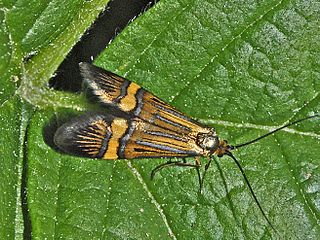
The longhorn moth or yellow-barred long-horn is a diurnal lepidopteran from the moths family Adelidae.
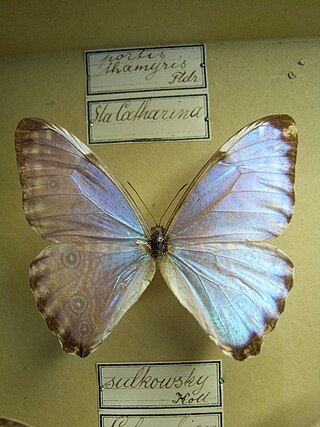
Morpho portis is a Neotropical butterfly. It is found in Brazil, Uruguay, Venezuela, Colombia, Peru, and Paraguay. Several subspecies and many forms have been described. The larvae feed on Gramineae.
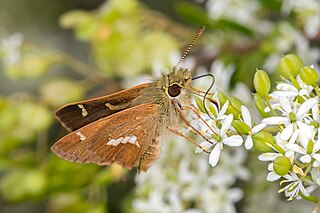
Dispar compacta, commonly known as the dispar skipper, barred skipper, or barred grass-skipper, is a species of butterfly in the family Hesperiidae. It was described by Arthur Gardiner Butler in 1882 as Telesto compacta and is endemic to eastern Australia.
Hyposmocoma trivitella is a species of moth of the family Cosmopterigidae. It was first described by Otto Swezey in 1913. It is endemic to the Hawaiian island of Kauai. The type locality is Haleakalā.
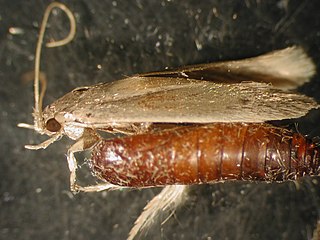
Opogona sacchari, the banana moth, is a moth of the family Tineidae. The species was first described by Wenceslas Bojer in 1856. It is native to the humid tropical and subtropical regions of sub-Saharan Africa, where it is also found in Madagascar, Mauritius, Réunion, Rodrigues Island, the Seychelles and St. Helena. It was first reported from the Canary Islands in the 1920s. In the 1970s, it was introduced into Brazil and Central America, and also appeared in Europe. It has been reported from Florida since 1986.

Isonomeutis amauropa is a species of moth in the Copromorphidae family. It is endemic to New Zealand where it can be found on both the North and South Islands. I. amauropa inhabits native forest particularly forest dominated by Rimu and native beech trees. The larvae of this species consumes margarodid scale insects that live under the bark of these trees. When mature the larvae pupate in a cocoon made of silk and covered in twigs and frass. This cocoon is normally placed under the bark of the same tree the larvae inhabited. Adults of I. amauropa are on the wing from September to February.

Synanthedon formicaeformis, the red-tipped clearwing, is a moth of the family Sesiidae and can be found in all of Europe, the eastern Palearctic realm, and the Near East. The larvae sometimes form pear-shaped galls on willows. It was first described by Eugenius Johann Christoph Esper in 1783.

Gesonia obeditalis is a species of moth of the family Noctuidae first described by Francis Walker in 1859. It is found from eastern Africa, the Seychelles, the Maldives and the Oriental tropics of India, Myanmar, Sri Lanka east to the Philippines, the Sula Islands and Australia. The adult moth has brown wings with a scalloped dark brown band near the margin. The hindwings are similar in pattern to the forewings but are a paler shade of brown.

Orenaia alpestralis is a species of moth in the family Crambidae.
Palaeomystella is a genus of moths in the family Momphidae.
Palaeomystella tibouchinae is a moth of the family Agonoxenidae. It is found in Brazil.
Palaeomystella oligophaga is a moth of the family Agonoxenidae. It is found in Brazil.

Idalus paulae is a moth in the family Erebidae. It is found in the Cordillera Volcanica Central, the Cordillera de Talamanca and the Cordillera Talamanca of Costa Rica. The habitat consists of rain forests and the margins of cloud forests, on both the Pacific and Atlantic slopes at altitudes between 1,400 and 2,230 meters.
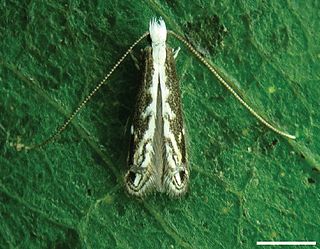
Spinivalva is a genus of moths in the family Gracillariidae. It contains only one species, Spinivalva gaucha, which is found in Brazil.
Palaeomystella rosaemariae is a moth of the family Agonoxenidae. It is found in the Atlantic Forest of Coxilha das Lombas in Brazil.
Palaeomystella tavaresi is a moth of the family Agonoxenidae. It is found in the Atlantic Forest at the Serra Bonita Reserve in Brazil.

Chrysorthenches halocarpi is a species of moth in the family Plutellidae. It was first described by John S. Dugdale in 1996. It is endemic to New Zealand and has been observed in the North and South Islands. The species inhabits native bush. Larvae have been collected in October and November. The larval hosts are Halocarpus bidwillii and H. biformis. Adults have been observed on the wing from November to February.















